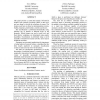391 search results - page 38 / 79 » Protein Classification Using Neural Networks |
VLSISP
2002
13 years 7 months ago
2002
In this paper two agglomerative learning algorithms based on new similarity measures defined for hyperbox fuzzy sets are proposed. They are presented in a context of clustering and...
BMCBI
2010
13 years 7 months ago
2010
Background: Ortholog detection methods present a powerful approach for finding genes that participate in similar biological processes across different organisms, extending our und...
ISMB
1993
13 years 9 months ago
1993
Weintroduce a parallel approach, "DT-SELECT," for selecting features used by inductive learning algorithms to predict protein secondary structure. DT-SELECTis able to ra...
ISMIR
2004
Springer
14 years 29 days ago
2004
Springer
This paper presents a system that extracts 109 musical features from symbolic recordings (MIDI, in this case) and uses them to classify the recordings by genre. The features used ...
ISMB
2000
13 years 9 months ago
2000
Knowing the number of residue contacts in a protein is crucial for deriving constraints useful in modeling protein folding, protein structure, and/or scoring remote homology searc...

